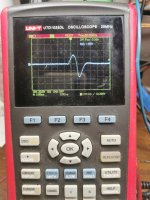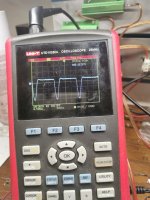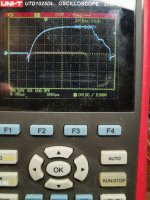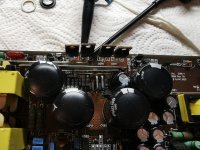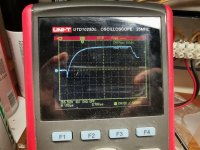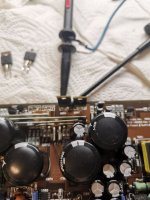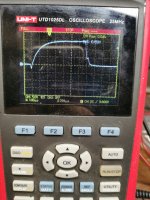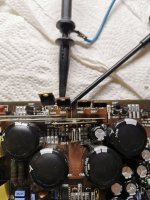Received this amp. Everything looks fine, until I inject a signal. Current draw is rising, output looks.. See picture.
The first picture is the amplitude at drain, without a signal. The other picture is the output with signal. Never had this issue.
The first picture is the amplitude at drain, without a signal. The other picture is the output with signal. Never had this issue.
Attachments
When does current draw increase?
How much does it increase and how long does the increase in draw take?
Does the current draw increase if the FETs are clamped to the heatsink?
What happens to the drain waveform when you inject signal?
How much does it increase and how long does the increase in draw take?
Does the current draw increase if the FETs are clamped to the heatsink?
What happens to the drain waveform when you inject signal?
Injected 100hz,its slowly increasing. I stopped at 5amps. The amplitude at drain is still the same, but moving, like normal when playing a frequency.
Everything is clamped to heatsink
Everything is clamped to heatsink
If you let it idle at 5 amps, which section of the heatsink heats up the quickest, the output FET area or the PS FET area?
If you let the amp idle with no input and you decrease the 12v supply voltage to near the point where the amp shuts off, does the current draw increase?
Are you saying that the amp will produce audio into a speaker?
If you let the amp idle with no input and you decrease the 12v supply voltage to near the point where the amp shuts off, does the current draw increase?
Are you saying that the amp will produce audio into a speaker?
Does the low-side drain for both output halves continue to swing the full 80v when you have only 1/2 of the sine wave on the output?
Do both positive and negative speaker terminals have the same signal?
Do you see the modulation going from 0% to 100% on the low-side drains?
Do both positive and negative speaker terminals have the same signal?
Do you see the modulation going from 0% to 100% on the low-side drains?
One output mosfet is shorted now. Irf 540.i have to check, if I have spare. Maybe only the mosfets makes this problem. Removed the broken one..
I've found that cycling main power quickly may actually blow output fets in these amps for little to no reason. You need to try and always use rem to cycle the amp on/off not your entire bench power supply switch. In these amps, they sort-of run a bit when REM is applied/removed, and ripping the main power off/on is rather abrupt on these.
So, changed the gate drive ic.. And installed for testing instead of irf540 a batch of FB260N... High pitch noise from the output filters, and high current draw..
If you pulse the remote, you will get drive to the outputs for about 15 seconds after removing the remote voltage. Check the drive on the gate legs of the output FETs before the end of the 15 seconds.
Its with fets inside. Without fets, I have a very good amplitude. If I adjust the Poti, the current goes a little bit down, so I expect it is for dead time.
Which FET location is that on?
The two trimmer pots are for over-current/load sensing and for DC offset.
The deadtime is produced with the 74HC132 that's flanked by the two 2.2k resistors.
The two trimmer pots are for over-current/load sensing and for DC offset.
The deadtime is produced with the 74HC132 that's flanked by the two 2.2k resistors.
That appears to be the low-side FET. The low-side gate drive uses a series connected diode and 10 ohm resistor to pulldown the drive. Check those components.
That looks OK.
Clamp everything back to the heatsink (with new heatsink compound) and check for audio into a load.
Clamp everything back to the heatsink (with new heatsink compound) and check for audio into a load.
- Home
- General Interest
- Car Audio
- Jl 500/1

